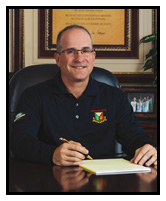Sharing Success – Tom Cortopassi
January 2020

What business are you in? That might sound like a naïve question. But how an organization defines its purpose directly influences how its members define their responsibilities and ultimately what they strive to accomplish on the organization’s behalf.
Many businesses are inwardly focused. They assume that their main purpose is selling a specific product or service. The problem with this inward facing approach is that it doesn’t necessarily match what matters most to the customer. So even if they do everything “right” according to their narrow definition of success, they still miss the boat when it comes to truly satisfying their customers. On the other hand, businesses that are outwardly focused try to see the world through the eyes of their customers.
As a result, how they define their business is often much broader, depending on what motivates their customers. Let me explain by sharing an example from my experience as a coffee consumer. From time to time, I attend business meetings away from my office which requires me to drive to a nearby town. About halfway there is a coffee shop where I sometimes stop to pick up a cup of coffee to drink in my car. Because the coffee outlet is located just off the highway, it experiences large fluctuations in customer demand. Sometimes there is no line. Other times, the line may be quite long. Either way, because I like the coffee, I don’t mind the wait.
However, what I do mind is that, whether or not they are “slammed” with high customer demand, their condiments station is poorly serviced. Sometimes they are out of cream. Other times, they have run out of napkins or stirrers. But for whatever reason, the condiments counter is routinely treated as an operational afterthought. And whenever employees behind the counter are alerted to condiment stockouts, they seem genuinely surprised. From an operational process standpoint, the way to solve this
particular challenge is actually pretty simple. The owner or the manager can assign a specific employee the responsibility of monitoring and refreshing the condiment station every few minutes, including when the restaurant is slammed. This last part is especially critical because proactively preventing stockouts of necessary supplies during peak demand keeps workflows running their smoothest.
By the way, I don’t blame the employees in this situation. They seem like hard workers and probably find these types of “interruptions” equally frustrating. So why does this condiment “stockout” problem keep repeating itself over time? My hunch is that whoever is managing the coffee shop is inwardly focused when it comes to defining what business they are in. I am guessing that they believe that they are in the business of preparing quality coffee drinks, rather than the business of satisfying coffee drinkers. The difference may seem subtle. But it is super important. If the business is just focused on “preparing coffee drinks,” what happens at the condiment counter might seem to be of secondary importance. On the other hand, if the business is focused on “speeding satisfied customers on their way,” then always keeping the condiment counter fully-stocked actually becomes “mission critical.” Why?
1) By definition, running out of condiments unnecessarily disappoints customers who count on using them, especially during peak demand when unexpectedly long lines have already delayed their departure.
2) From an operational viewpoint, having to respond to these types of stockouts on an “emergency” basis (instead of in an orderly way) disrupts workflows for multiple employees and often leads to additional time-consuming mistakes.
3) There is plenty of competition, and unsatisfied customers will seek another coffee house that serves good coffee and provides excellent service. Trying to see the world through your customers’ eyes isn’t always easy. But it definitely pays off over time!
Until next time, Ciao!
Yours,
Tom Cortopassi, President and Co-Owner

